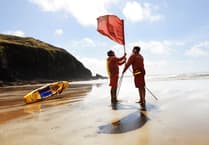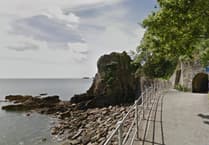During the summer months, the Rotary Club of Saundersfoot held several duck races in Saundersfoot Harbour courtesy of the Harbour Commissioners that were really well supported by the public.
On such occasions, the duck selling took place in close proximity to other stalls occupied by volunteers raising funds for the RNLI. Several Rotarians own boats and they fully appreciate the important role that RNLI play in rescuing people from the sea; in addition, the wife of one of the club members is an RNLI Saundersfoot branch member.
As a result, it was agreed that the Rotarians would link with the RNLI members to arrange a duck race, with the profits contributing to the fund-raising undertaken by the Saundersfoot branch of the RNLI. The race took place on a beautifully sunny summer's day and was a great success. It was a great example of two different fund-raising organisations working together in harmony.
On a chilly October evening, with Rotarians wrapped up in coats and scarves, they walked through Tenby town towards the lifeboat station. As they neared the station, they looked out at the dark sea and listened to the waves crashing on the shoreline. They were glad to be visiting the lifeboat station and not taking a boat trip into the darkness.
Inside the lifeboat station, the members of the Rotary Club of Saundersfoot again met with the Saundersfoot RNLI members who had been involved with the Saundersfoot duck race, but their host for the evening was David Rees, who gave a fascinating talk about the history of the RNLI and Tenby lifeboat station.
David explained that Sir William Hillary first thought of the idea of a national institution for the preservation of life and property from shipwreck which started in 1824. The first lifeboat station in Tenby was established by the Shipwrecked Fishermen and Mariners Royal Benevolent Society in 1852, but this was taken over by the RNLI in 1854.
In those early days, the boat was dragged on a cart to the sea by a team of volunteers who then rowed the boat through the surf. One of the oars from this first lifeboat is kept in the current lifeboat station and the Rotarians marvelled at the stamina of the men who rowed through treacherous seas with such large heavy oars. Fortunately, from 1923, there were motorised lifeboats at Tenby, but these were nothing like the motorised lifeboats we see today.
The existing Tamar Class lifeboat (the Haydn Miller) was put into service in 2006, and is a fascinating craft, with self-righting ability and two 1,000hp engines.
Whilst it is virtually unsinkable, it still needs a crew of brave volunteers to rescue people in distress at sea. The volunteers come from all walks of life and respond instantly to their individual pager call; typically the lifeboat is launched within seven to 10 minutes of such a call being received.
At the end of the visit, club president Neil Sefton thanked David Rees for the excellent way he had explained the history and work of the station and thanked the volunteers from Saundersfoot RNLI for arranging the visit.





Comments
This article has no comments yet. Be the first to leave a comment.